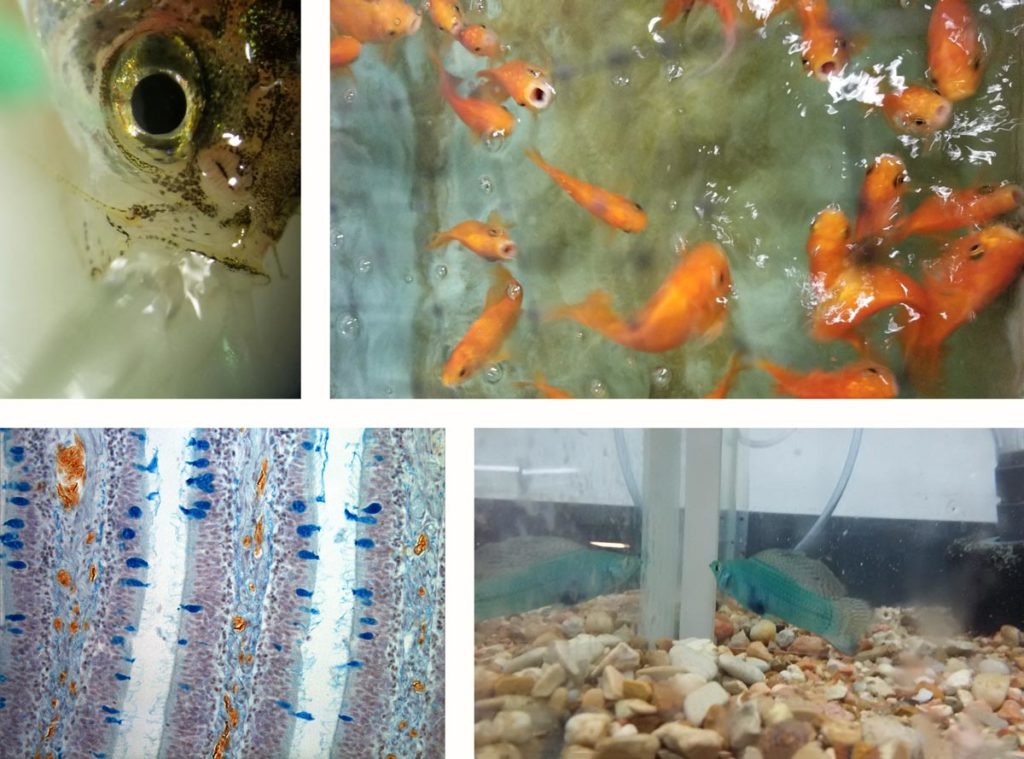Research
Current research at Huertas laboratory aims to understand olfaction in vertebrates using fish as a model. Fish have a highly sensitive sense of the smell which is involved in the control of critical physiological functions as reproduction, feeding, navigation, prey detection and alarm responses. Our different lines of research include basic research projects that seek to understand the olfactory process in vertebrates and applied research projects that target aquaculture practices and environmental management.
Olfactory immune function

This is a collaborative research with Dr Salinas in the University of New Mexico. Our research aims to unravel the mechanism of olfactory detection of pathogens in fish and its relationship with the immune response. This research discovered a new olfactory function in vertebrates. Fish can smell virus and bacteria, and the nervous signal activates immune responses in the brain almost instantly. Our investigation is still ongoing and financed by NSF. This line of research joined the COVID research task, using zebrafish as a model for infectious diseases in humans.
Publications
Kraus, A., Casadei, E., Huertas, M., Ye, C., Bradfute, S.B., Boudinot, P., Levraud, J.-P., Salinas, I., (2021). A zebrafish model for COVID-19 recapitulates olfactory and cardiovascular pathophysiologies caused by SARS-CoV-2. bioRxiv.
Mancha, F. and Huertas, M. (2020). Tracing the Olfactory Circuit of Bacteria and Virus in Rainbow Trout (Oncorhynchus mykiss), In FASEB Journal, San Diego, California.
Ali Sepahi, Kraus, A., Johnston, C.A., Galindo-Villegas, J., Kelly, C., García-Moreno, D., Muñoz, P., Mulero, V., Huertas, M. and Salinas, I. (2018). Olfactory sensory neurons mediate ultra-rapid antiviral immune responses in teleosts in a TrkA-dependent manner. PNAS 16 (25) 12428–12436.
Mancha, F., Salinas, I., and Huertas, M. (2019). Neural Circuits and Olfactory Responses to Neurotropic Viruses in Trout. FASEB Journal 33, lb618–lb618.
Effects of nitrite in olfaction
Nitrite is a toxic byproduct of nitrogen metabolism in fish. High nitrite concentration is a recurrent problem in aquaculture that can lead to high mortalities, either by acute toxic episodes or by reducing the quality of the culture water that leads to stress and diseases. At this moment we have two lines of research. The first one is founded by USDA exploring the effect of nitrites in nose microbiome in catfish and associated disease. The second line of research is founded by an internal grant at Texas State University and is exploring the effect of nitrites in maternal transfer live bearing Xiphophorus species.
Publications
Ortiz, W., Carlos-Shanley, C. and Huertas, M. (2021). Bacteria fight club: Identifying probiotics for goldfish. In International Research Conference for Graduate Students at TXST.
Trujillo, I., Martinez, M., and Huertas, M. (2020). Behavioral Effects of Nitrite on Goldfish (Carassius auratus), In FASEB 34, 1-1.
Martinez, M., Gomes, A., Mancha, F. C. and Huertas, M. (2020). Toxicokinetic of sublethal concentrations of nitrite in goldfish (Carassius auratus), In FASEB 34, 1-1.
Ortiz, W., Carlos-Shanley, C. and Huertas, M. (2020). The impacts of sublethal nitrite exposure on goldfish (Carassius auratus) microbiomes, In FASEB 34, 1-1.
Valdez-Oranday, D. F., Martinez, M., and Huertas, M. (2019). Biomarkers of neurodegeneration in goldfish exposed to nitrite, In FASEB 33, 662.613-662.613.
Effects of nanoplastic in olfaction
Aquatic pollutants can affect fish olfaction at much lower concentration that the described for acute effects. Since olfaction drives several physiological functions in fish (e.g., reproduction, food foraging, predator recognition, migration), irritation of fish nose due to common pollutants, like nanoplastics, can lead to a dramatic decrease of fish fitness in the long term.
Publications
Stoeber, H., and Huertas, M. (2019). Effects of Polystyrene Nanoplastics on Goldfish Olfactory Function. The FASEB Journal 33, lb616–lb616.
Fish chemical communication

Dr Huertas PhD and postdoctoral work focused on pheromonal communication in fish. She mainly worked with three models: European eel (PhD and first postdoctoral), tilapia (first postdoctoral) and sea lamprey (second postdoctoral). The main findings showed that eels use reproductive pheromones, and tilapia males release a urinary pheromone that modulates female endocrine axis. Moreover, the first aquatic vertebrate migratory pheromone and a pheromone antagonist was identified in sea lamprey. Currently, Huertas lab is currently working in multimodal communication in fish using the live bearing sailfin molly.
Publications
Hendrix, A., and Huertas, M. (2020). Multimodal communication modulates swimming behavior in sailfin molly (Poecilla Latipinna), In FASEB 34, 1-1.
Buchinger, T., Scott, A., Fissette, S., Brant, C., Huertas, M., Li, K., Johnson, N. and Li, W. (2020). A pheromone antagonist liberates female sea lamprey from a sensory trap to enable reliable communication, PNAS 117, (13) 7284–7289. Collaboration with Dr Li Lab.
McKenna, B., Gabor, C. R., and Huertas, M. (2019). Conspecific chemical communication in a live-bearing fish, Poecilia latipinna, In Integr Comp Biol. 59
Bristow, M. L., Gabor, C., and Huertas, M. (2019). Conspecific chemical cues modulate reproductive physiology and behavior in a live-bearing fish, In FASEB 33, lb429-lb429.
Ke Li, Brant, C., Huertas, M., Hessler, E., Mezei, G., Hoye, T.R. and Li, W. (2018). Fatty-acid derivative acts as a sea lamprey migratory pheromone. PNAS. 115 (34): 8603–8608. Collaboration with Dr Li Lab.
Buchinger, T., Li, K., Huertas, M., Baker, C. F., Jia, L., Hayes, M. C., Li, W., Johnson, N. (2017). Phylogenetic distribution of a male pheromone that exploits a nonsexual preference in lampreys. Journal of Evolutionary Biology. 30 (12): 2244–2254. Collaboration with Dr Li Lab.

